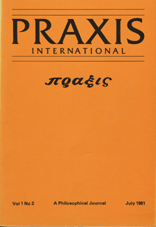Avant-Garde et Avant-Gardisme: Deux faux Concepts?
Avant-Garde and Avant-Gardism: Two Wrong Concepts
Author(s): Jean-Michel PalmierSubject(s): Philosophy
Published by: Blackwell Publishing Ltd
Summary/Abstract: The term avant-garde covers many artistic currents — some oriented to the political left, while others, like Italian Futurism, flirted with fascism. The importance of the Russian avant-garde in the Twenties has led many critics to associate political and artistic avant-gardism. The term is ambiguous and Western historians have emphasized the artistic side, whereas Soviet historians tie avant-garde to a political struggle for a better, more just, more humane world. Are the relations between artistic and political avant-garde mystified and mythified? This essay traces the original meaning of avant-garde and its introduction into aesthetics with Saint-Simonians, the semantic changes and different ideological types, especially in the twenties, as artists and writers, attracted by radical ideals, alternated between fascism and communism. Art movements are inseparable from social changes which affect the ideology of avant-gardes and their formal aspect. In the twenties, the avant-garde shows both a social and political vision and a purely formalistic vision. But the avant-gardes of the fifties, especially the New York School, while questioning American life styles and the fetishism of merchandise, are elitist. There is a hiatus between art and the public. The proletariat does not have intrinsically revolutionary tastes. To prevent art from remaining in an elitist and mercantile ghetto we must bridge the hiatus by developing points of creation and confrontation, and by artistic education.
Journal: PRAXIS International
- Issue Year: 2/1982
- Issue No: 2
- Page Range: 191-203
- Page Count: 13
- Language: French

